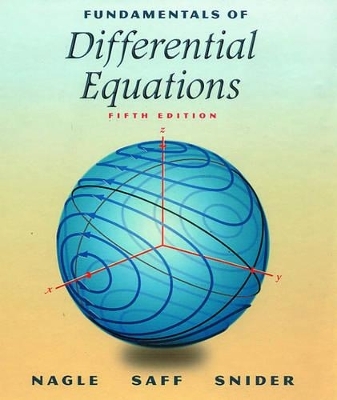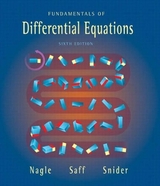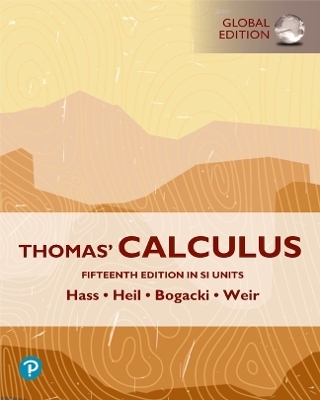
Fundamentals of Differential Equations
Pearson
978-0-201-33868-3 (ISBN)
- Titel erscheint in neuer Auflage
- Artikel merken
*New applications-driven sections have been added to the chapter on linear second-order equations. *The chapter regarding the introduction to systems and phase plane analysis has been reorganized and modernized to better facilitate student understanding of the material. *More material on dynamical systems has been added. *A new section on the phase line has been added to the beginning of the text. *Group Projects relating to the material covered appear at the end of each chapter. *Revised exercise sets provide fresh material for instructors who have used the text before. *Updated Interactive Differential Equations CD is keyed specifically to the text, and included free with every book. *An updated Instructors MAPLE Manual, tied to development of the text, with suggestions on incorporating MAPLE into the courses, and including sample worksheets for labs, is available. *The texts also allow optional use of Computer Algebra Systems, with many exercises and projects included to let students use software to solve interesting and realistic problems and exercises.
*Necessary proofs in a conceptual presentation are always included, but may be skipped, allowing flexibility in the level of coverage of proofs. *Technical Writing Exercises are included at the end of most chapters, to build students communication skills. *Methods for approximating solutions to numerical algorithms are presented, along with computer program outlines, and are introduced early in the text. The computer program outlines can be used with many different computer languages. *Historical footnotes are given throughout, providing a context for topics.
(Each chapter ends with a Chapter Summary, Review Problems and Group Projects.) 1. Introduction. Background. Solutions and Initial Value Problems. Direction Fields. The Phase Line. The Approximation Method of Euler. 2. First Order Differential Equations. Introduction: Motion of a Falling Body. Separable Equations. Linear Equations. Exact Equations. Special Integrating Factors. Substitutions and Transformations. 3. Mathematical Models and Numerical Methods. Mathematical Modeling. Compartmental Analysis. Heating and Cooling of Buildings. Newtonian Mechanics. Improved Eulers Method. Higher Order Numerical Methods: Taylor and Runge-Kutta. Professional Codes for Solving Initial Value Problems. 4. Linear Second Order Equations. Introduction: The Mass-Spring Oscillator. Linear Differential Operators. Fundamental Solutions of Homogeneous Equations. Reduction of Order. Homogeneous Linear Equations with Constant Coefficients. Auxiliary Equations with Complex Roots. Superposition and Nonhomogeneous Equations. Method of Undetermined Coefficients. Variation of Parameters. Qualitative Considerations for Variable-Coefficient and Nonlinear Equations. A Closer Look at Free Mechanical Vibrations. A Closer Look at Forced Mechanical Vibrations. 5. Introduction to Systems and Phase Plane Analysis. Interconnected Fluid Tanks. Introduction to the Phase Plane. Elimination Method for Systems. Coupled Spring-Mass Systems. Electric Circuits. Numerical Methods for Higher Order Equations and Systems. Dynamical Systems, Poincar? Maps, and Chaos. 6. Theory of Higher Order Linear Differential Equations. Basic Theory of Linear Differential Equations. Homogeneous Linear Equations with Constant Coefficients. Undetermined Coefficients and the Annihilator Method. Method of Variation of Parameters. 7. Laplace Transforms. Introduction: A Mixing Problem. Definition of the Laplace Transform. Properties of the Laplace Transform. Inverse Laplace Transform. Solving Initial Value Problems. Transforms of Discontinuous and Periodic Functions. Convolution. Impulses and the Dirac Delta Function. Solving Linear Systems with Laplace Transforms. 8. Series Solutions of Differential Equations. Introduction: The Taylor Polynomial Approximation. Power Series and Analytic Functions. Power Series Solutions to Linear Differential Equations. Equations with Analytic Coefficients. Cauchy-Euler (Equidimensional) Equations Revisited. Method of Frobenius. Finding a Second Linearly Independent Solution. Special Functions. 9. Matrix Methods for Linear Systems. Introduction. Review 1: Linear Algebraic Equations. Review 2: Matrices and Vectors. Linear Systems in Normal Form. Homogeneous Linear Systems with Constant Coefficients. Complex Eigenvalues. Nonhomogeneous Linear Systems. The Matrix Exponential Function. 10. Partial Differential Equations. Introduction: A Model for Heat Flow. Method of Separation of Variables. Fourier Series. Fourier Cosine and Sine Series. The Heat Equation. The Wave Equation. Laplaces Equation. (Chapters 11-13 are contained in Fundamentals of Differentials with Boundary Value Problems, Third Edition (0-201-33867-X).) 11. Eigenvalue Problems and Sturm-Liouville Equations. Introduction: Heat Flow in a Nonuniform Wire. Eigenvalues and Eigenfunctions. Regular Sturm-Liouville Boundary Value Problems. Nonhomogeneous Boundary Value Problems and the Fredholm Alternative. Solution by Eigenfunction Expansion. Greens Functions. Singular Sturm-Liouville Boundary Value Problems. Oscillation and Comparison Theory. 12. Stability of Autonomous Systems. Introduction: Competing Species. Linear Systems in the Plane. Almost Linear Systems. Energy Methods. Lyapunovs Direct Method. Limit Cycles and Period Solutions. Stability of Higher-Dimensional Systems. 13. Existence and Uniqueness Theory. Introduction: Successive Approximations. Picards Existence and Uniqueness Theorem. Existence of Solutions of Linear Equations. Continuous Dependence of Solutions. Appendices. Newton's Method. Simpson's Rule. Cramers Rule. Method of Least Squares. Runge-Kutta Precedure for n Equations. Answers to Odd-Numbered Problems. Index.
| Erscheint lt. Verlag | 15.12.1999 |
|---|---|
| Sprache | englisch |
| Maße | 240 x 241 mm |
| Gewicht | 1463 g |
| Themenwelt | Mathematik / Informatik ► Mathematik ► Analysis |
| ISBN-10 | 0-201-33868-8 / 0201338688 |
| ISBN-13 | 978-0-201-33868-3 / 9780201338683 |
| Zustand | Neuware |
| Haben Sie eine Frage zum Produkt? |
aus dem Bereich



